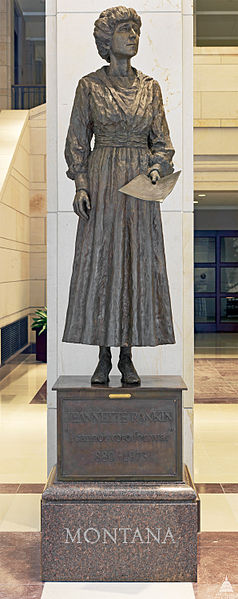In a few short days, Scotland will vote on independence from the United Kingdom. This impending referendum has left me musing on the role that Scots played in the history of Montana. Last week I profiled two pioneering cattlemen who helped shape Montana. Today I want to look at another pioneering spirit with Scotch blood in her veins.

The bronze statue in in the U.S. Capitol’s Emancipation Hall shows a young, somber woman, staring into a distance only she can envision. Over and over again in photographs is this gaze repeated, penetrating eyes in a softly somber face, more often than not topped with a hat of near ridiculous proportions, worn with perfect poise. Jeannette Rankin’s is, quite possibly, Montana’s most famous female face. Born in 1880 to the children of Scottish immigrants, Rankin grew up on a farm near Missoula, Montana. She attended college in Missoula and then studied social work at the New York School of Philanthropy. She became a lobbyist for the National American Women’s Suffrage Association, and returned to Montana in 1914 to help lead the Montana suffrage movement.

Although Montana’s most famous suffragist, Rankin came to the fight rather late. In fact, the suffrage movement in Montana began as early as 1889 when proponents pushed to have suffrage language included in the state constitution. The constitution allowed tax-paying women the right to vote on tax issues, and women already had the right to vote in school elections. Fragmented suffrage groups pushed equal suffrage amendments almost continuously between 1895 and 1911. In 1911, however, a more organized suffrage movement began to build steam. In 1913 both houses passed a suffrage bill, opening the issue to a popular vote in 1914. Rankin joined the campaign for the popular vote. The dedicated women (and men) at the Montana Equal Suffrage Association canvassed the state, many travelling heroic distances over the vast territory. The amendment passed, and in 1914 Montana became the eleventh state to grant (white) women equal suffrage.
Two years later, Jeannette Rankin mobilized this same grassroots organization to run for U.S. Representative. She won, becoming the first woman delegate to Congress a full four years before women gained the right to vote across the nation. 1916 was an auspicious year for women in Montana as two women were elected to the state’s House of Representatives. In 1917 President Woodrow Wilson asked Congress to declare war on Germany. This was the first vote of Rankin’s career. Rankin, with more than fifty other delegates voted against the war. During her term she fought for various laws that would benefit women and Montana, but her first was her most famous vote.
For the next two decades she continued to fight for women’s rights. Then in 1940, with America again on the cusp of war, she ran again for U.S. Congress. Again Montana sent her to Washington. This time, she became the lone dissenter when Congress voted to declare war on Germany. She thus became the only person to vote against both wars.
She spent the rest of her life as a political activist, fighting for the rights of women and children, and passionately advocating pacifism. She made many trips abroad and in 1968 orchestrated a protest against the Vietnam War. She died in 1973, still a very controversial figure. In 1983 the Montana legislature honored her by voting to have her statue place in the U.S. Capitol.
For more information about Jeannette Rankin and Montana’s women, visit montanawomenshistory.org
